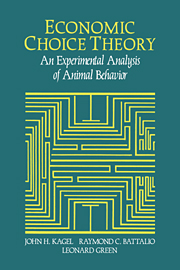Book contents
- Frontmatter
- Contents
- Preface
- Chapter 1 Introduction
- Chapter 2 Commodity-choice behavior I: Some initial tests of the theory
- Chapter 3 Commodity-choice behavior II: Tests of competing motivational processes and the representative consumer hypothesis
- Chapter 4 Labor-supply behavior I: Initial tests of the theory with some public policy implications
- Chapter 5 Labor-supply behavior II: Tests of competing motivational processes and earnings distributions for animal workers
- Chapter 6 Choices over uncertain outcomes
- Chapter 7 Intertemporal choice
- Chapter 8 Summing up
- Bibliography
- Index
Chapter 3 - Commodity-choice behavior II: Tests of competing motivational processes and the representative consumer hypothesis
Published online by Cambridge University Press: 22 March 2010
- Frontmatter
- Contents
- Preface
- Chapter 1 Introduction
- Chapter 2 Commodity-choice behavior I: Some initial tests of the theory
- Chapter 3 Commodity-choice behavior II: Tests of competing motivational processes and the representative consumer hypothesis
- Chapter 4 Labor-supply behavior I: Initial tests of the theory with some public policy implications
- Chapter 5 Labor-supply behavior II: Tests of competing motivational processes and earnings distributions for animal workers
- Chapter 6 Choices over uncertain outcomes
- Chapter 7 Intertemporal choice
- Chapter 8 Summing up
- Bibliography
- Index
Summary
What the empirical data do confirm is that demand curves generally have negative slopes. … But negatively sloping demand curves could result from a wide range of behaviors.
(Simon, 1979, p. 496)As the experiments reported in Chapter 2 demonstrate, income-compensated price changes reliably result in reduced consumption of goods whose price has increased. Further, in the case of normal goods, income-constant demand curves are negatively sloped. Although these studies provide new evidence to support some of the standard operating principles of economic analysis, the question remains, what decision rule, or behavioral process, underlies these outcomes? In this chapter, we examine competing behavioral allocation rules to determine which ones best organize the data. We consider random behavior models, psychological/biological models of choice, and utility function formulations commonly employed in the economics literature.
We consider four competing behavioral allocation rules. The first is Becker's (1962) irrational choice mode, in which essentially random behavior controls choices. That is to say, negatively sloped demand curves do not result from any explicit utility-maximizing process but are incidental to random behavior in conjunction with changes in the budget constraint. The second rule is the matching law (Herrnstein, 1961, 1970), which is prominent in the psychology literature. Under some conditions, the matching law produces optimizing outcomes. Under others, it results in suboptimal behavior. The last two rules considered are explicit utility-maximizing formulations. The first of these, proposed by a number of biologists and psychologists, is that behavior is motivated by attempts to minimize deviations from some optimal-state values (Houston and McFarland, 1980; Staddon, 1979a).
- Type
- Chapter
- Information
- Economic Choice TheoryAn Experimental Analysis of Animal Behavior, pp. 47 - 78Publisher: Cambridge University PressPrint publication year: 1995



